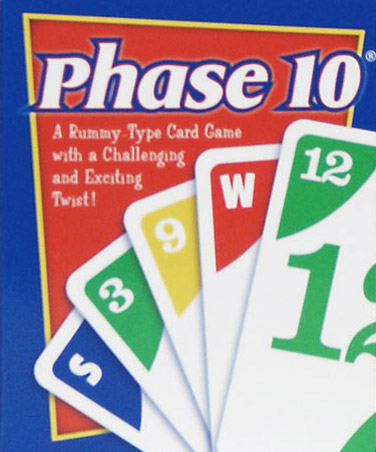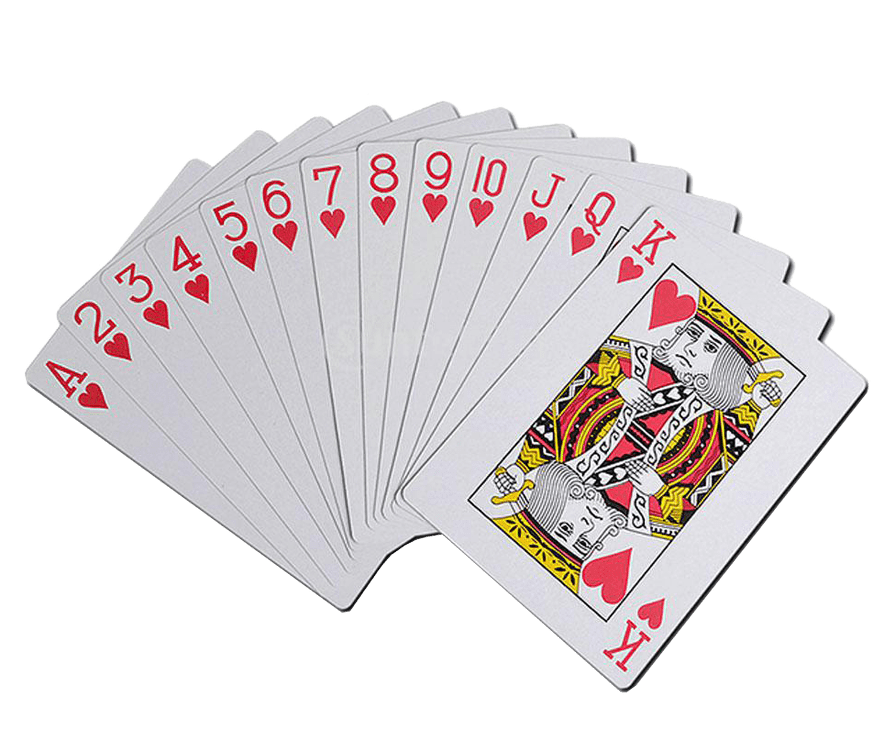Phase 10 - Based on a variant of rummy known as Liverpool rummy
By Mattel

Phase 10

- Designer: Kenneth Johnson
- Publisher: Mattel
- Release Date: 1982
- Based on the game: Rummy (Liverpool Rummy)
- Players: 2 - 6
Description
The Phase 10 card game, as the name suggests, is played in 10 phases, each demanding a unique sequence. This game is very addictive once you get a hang of it.
This card game was developed by Kenneth Johnson in 1982, and is marketed and sold by Mattel. Phase 10 is often considered to be similar to Rummy, due to the concept of sequences both games share. The game is also one of Mattel’s best-selling games, after UNO.
Phase 10 can be played by a minimum of 2 to a maximum of 6 players. The box contains a total of 108 cards, out of which 8 are Wild cards, 4 are Skip cards, and the remaining are classified into 4 colors with 24 cards each.
Objective
The object of the game is to be the first person to complete all ten phases. In the case of two players completing the last phase in the same hand, the player who completed the last phase with the lowest overall score is the winner. If those scores also happen to be tied, a tiebreaker round is played where the tying players attempt to complete phase ten (or in variants, the last phase each player had tried to complete in the previous round).
For each hand, each player's object is to complete and lay down the current phase, and then rid their hand of remaining cards by discarding them on laid-down Phases, called hitting. The player who does this first wins the hand and scores no penalty; all other players earn penalty points according to the value of cards remaining in their hand.
Special Cards
Wild
A Wild card may be used in place of a number card and can be used as any color to complete any phase. Original print runs of Phase 10 had two Wilds in each color; to reduce confusion, current print runs use black Wilds.
- More than one Wild card may be used in completing a Phase. Players can use as many Wild cards as they want as long as they use one natural card.
- Once a Wild card has been played in a Phase, it cannot be replaced by the intended card and used elsewhere. It must remain as that card until the hand is over.
- If the dealer starts the discard pile with a Wild card, the card may be picked up by the first player.
- A Wild card may not be used as a Skip card.
Skip
Skip cards have only one purpose: to cause another player to lose a turn. To use, a player discards the Skip card on their turn and chooses the player who will lose a turn.
- When a Skip card is drawn it may be discarded immediately or saved for a later turn.
- A Skip card may never be picked up from the discard pile.
- A Skip card cannot be used to complete any phase, including Phase 8 (seven cards of one color). The original print runs of Phase 10 had blue Skip cards, causing confusion with normal blue cards in deck; Skip cards are now black in current editions.
- Any player can be skipped, not just the person who would normally play next.
- A player cannot be skipped twice in the same round; they must lose turn in the round before being skipped again. (They can be skipped twice in a row but not until they miss their turn.)
- If the first card that starts the discard pile is a Skip card then the first players first turn is skipped.
Phases
A phase is a combination of cards. Phases are usually composed of sets (multiple cards of the same value), runs (multiple cards in consecutive ascending order), cards of one color, or a combination of these. As the name suggests, there are ten phases: Also if a player gets 30 or 31 cards they can skip a phase. Original and Master's Edition Phases:
- Phase 1: 2 sets of 3
- Phase 2: 1 set of 3 + 1 run of 4
- Phase 3: 1 set of 4 + 1 run of 4
- Phase 4: 1 run of 7
- Phase 5: 1 run of 8
- Phase 6: 1 run of 9
- Phase 7: 2 sets of 4
- Phase 8: 7 cards of one color
- Phase 9: 1 set of 5 + 1 set of 2
- Phase 10: 1 set of 5 + 1 set of 3
Phase 10 Twist Phases
- Phase 1: 3 sets of 3
- Phase 2: 4 sets of 2
- Phase 3: 1 set of 5 + 1 run of 4
- Phase 4: 2 sets of 3 + 1 run of 3
- Phase 5: 1 set of 3 + 1 run of 6
- Phase 6: 2 runs of 4
- Phase 7: 1 run of 4 + 4 cards of one color
- Phase 8: 1 run of 5 of one color
- Phase 9: 8 cards of one color
- Phase 10: 9 cards of one color
Each player can make only one phase per hand. For instance, a run of nine cards when the player is on Phase 4 cannot also count as Phase 5 and/or 6. In the original and Phase 10 Twist versions, the phases must also be completed in order, but the Master's Edition variant has a rule allowing players to choose the phase they will attempt to complete after being dealt their hand and before play begins.
Completing phases
If, during a player's turn, they are able to make their current Phase with the cards in their hand, they lay the Phase down, face-up on the table before discarding.
- Phases must be made in order, from 1 to 10.
- A player must have the whole Phase in hand before laying it down.
- A player may lay down more than the minimum requirements of a Phase, but only if the additional cards can be directly added to the cards already in the Phase. For instance, if a Phase requires a set of 3 but the player has four of that card, the player may lay down all four cards when completing the Phase.
- Only one Phase may be made per hand. For instance, a player who must make a run of 7 cards (Phase 4) cannot complete the next two Phases in the same hand by laying down a run of 9.
- If a player successfully makes a Phase, then they try to make the next Phase in the next hand. If they fail to make a Phase, they must try to make the same Phase again in the next hand. As a result, players may not all be working on the same Phase in the same hand.
- Players receive credit for making a Phase as soon as it is laid down. A player does not need to win the hand in order to receive credit for the Phase. Several players will often complete their Phase in the same hand.
- As soon as a person finishes a phase the round ends.
Hitting
Hitting is the way to get rid of leftover cards after making a Phase. A hit is made by putting a card directly on a Phase already laid down. The cards must properly fit with the cards already down. Before a player can make a hit, their own Phase must already be laid down. A player may only hit during their turn. A player may hit any combination of their own Phase and other player's Phases, and may hit with as many cards as can be played from the player's hand on a single turn. Players are not allowed to replace a wild card in a Phase with the card from their hand matching the card the Wild stands for. Replacing Wild Cards is possible Variant Rule.
Going out / finishing a hand
After laying down a Phase, players try to "go out" as soon as possible. To go out, a player must get rid of all of their cards by hitting and discarding. The player to go out first wins the hand. The winner of the hand, and any other players who also completed their Phase, will advance to the next Phase for the next hand, while any player not able to complete their Phase remain on that same Phase for the next hand. Players count up the total value of cards left in their hands (the fewer cards left in their hand, the better) and score them as follows:
- five points(5) for each card with value 1 - 9
- ten points(10) for each card with value 10 - 12
- fifteen points(15) for a Skip
- twenty-five points(25) for a Wild
Each player's score for the hand is added to that player's running total (players who did not complete their Phase cannot have a score of less than 50 for the hand and often have far more with the inclusion of extra points for large values and wilds; this is known as being "set" similar to Hearts or Spades), the deal rotates to the left, all the cards are shuffled and a new hand begins. Again, if a player did not complete their Phase before another player went out, they must work on the same Phase again in the next hand.
Winning
If only one player is attempting Phase number 10 on the hand and they complete the Phase, they become the winner and the game ends immediately. If two or more players complete Phase 10 in the same hand, then the player who has competed phase ten and has the lowest total points is the winner. In the event of a tie, the players that tied replay Phase number 10 and the first player to complete their phase and discard all their cards wins.
